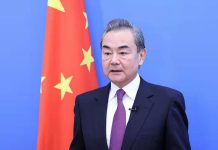BEIJING: China is aiming to lift its economic, technological and national strength to a new, higher stage in the next five years, under a sweeping blueprint that has put heavy emphasis on improving domestic economic conditions, boosting technological innovation and national security, while leaving sufficient room to cope with mounting risks and challenges, officials said on Monday.
In a break from a decades-long tradition, China’s 14th Five-Year Plan (2021-25) did not set a specific GDP growth target – for the first time in the country’s history of making up five-year plans – but instead stresses goals in other indicators, including unemployment rate, energy consumption and carbon dioxide emissions, in line with a mission to improve people’s livelihood and quality of development. The change also reflected mounting uncertainties for the Chinese economy, including severe global conditions, a shaky domestic recovery with constraints on consumption and investment, officials and analysts said.
But the world’s second-largest economy is widely expected to continue to take the lead in the global recovery from the COVID-19 in the coming years, and various policy initiatives in sectors such as consumption, environmental protection, market reform and opening are set to offer great opportunities for businesses and products from around the world, foreign firms and experts noted.
The 14th Five-Year Plan has been submitted for review at the ongoing two sessions. Coming at a critical inflection point for China’s social and economic development, the sweeping plan – with 192 chapters and 74,000 Chinese characters – offered ambitious development goals and detailed plans for the next five years, officials said on Monday. Among the key highlights are two historic firsts. For the first time, the new Five-Year Plan did not include a specific GDP growth target and instead announced that growth would be kept in “reasonable range” and an annual target would be set based on the specific conditions each year. In the 13th Five-Year Plan (2016-20), a growth target of above 6.5 percent on average was set. While GDP growth was maintained above 6.5 percent in the first three years, the COVID-19 pandemic brought the five-year average to around 5.7 percent.
Also for the first time, the plan contained a special section for development security, aiming to bolster national security system and capabilities and setting arrangements to ensure food, energy and financial security. The plan contains 20 main indicators covering a wide range of areas, including eight obligatory targets, with seven focusing on ecological protection and security support. Among them, targets for food and energy production were included in the five-year plan for the first time.
On food security, for example, the new plan said that China would adhere to the 1.8 billion mu (120 million hectares) red line of cultivable land to ensure food security.
“In setting the target, [the plan] adheres to science and rationality, and it is inspiring and practical, while leaving room for dealing with uncertainties,” Hu Zucai, deputy director of the National Development and Reform Commission (NDRC), the country’s top economic planner, told a press conference on Monday. Specifically, the plan aims to implement a “dual circulation” development strategy that focuses on boosting the domestic market, enhancing technological self-efficiency and independence with significant increase in research and development (R&D), and bolstering environmental protection through investments in renewable energy.
– The Daily Mail-Global Times News exchange item
For example, basic R&D expenditure is set to grow over 7 percent during the new five-year period, outpacing anticipated economic growth, and the environmental protection sector is set to reach a trillion yuan, officials said.
“The overarching theme of the 14th Five-Year Plan is improving our own domestic conditions, boosting quality of growth and people’s livelihood, and strengthening environmental protection,” Chen Fengying, a research fellow at the China Institutes of Contemporary International Relations, told the Global Times on Monday. She added that the plan is ambitious and pragmatic by taking into account the risks and challenges ahead.
At a press conference on Monday, officials also acknowledged lingering challenges that need to be addressed, even as the country aims for higher development goals.
“The sustained and stable recovery of our country’s economy still faces some risks and challenges,” Ning Jizhe, deputy head of the NDRC, said at the briefing, pointing to the lingering COVID-19 pandemic, complex and severe global economic conditions with increased instability and uncertainty, and still incomplete domestic recovery with constrained consumption and investment.
In addition, China is also facing an increasingly deteriorating external environment, as the US is seeking to crack down on China in a wide range of areas, from trade to technology, to finance.
“Considering that there are still great uncertainties in the external environment in the next five years, not setting a specific quantitative growth target will help more actively, proactively and calmly respond to various risks and challenges,” said Hu from the NDRC.
Global confidence
However, despite the risks and certainties, China’s economy is widely expected to further consolidate its lead in the global recovery from COVID-19 with relatively high speed growth, while its ever-expanding consumer goods market is set to overtake that of the US as the world’s largest.
While officials did not set a specific growth target, analysts said that an average growth of between 4.7 percent and 5 percent is needed for the next 15 years to reach various goals which have been set for 2035. That would put China in place as one of the world’s biggest growth drivers.
“The 14th Five-Year Plan focuses on domestic development, but, given the size of the Chinese economy and the important role it plays in the global economy, the plan also offers a bright spot for the global economy at this difficult time,” Bai Ming, deputy director of the Ministry of Commerce’s International Market Research Institute, told the Global Times on Monday.
China has contributed nearly 30 percent in global growth on average over the past two decades, the top growth driver since 2006, according to officials and experts. In the next five to 10 years, China will continue to contribute between 25 percent and 30 percent to global economic growth, experts said.
The 14th Five-Year Plan has already drawn widespread attention from foreign businesses in China, with many expressing interest in new development focuses in areas such as environmental protection, technological innovation and pharmaceuticals.
“Not only has China successfully managed the COVID-19 outbreak and become the only country to have economic growth in 2020, it also has a clear path forward to become a leading driver of technological innovation. More importantly, China’s focus on sustainable development is an important goal that British businesses are keen to support,” the British Chamber of Commerce in China said in a statement it sent to the Global Times.
US medical device producer Boston Scientific, which recently signed an agreement on equity investment, technology transfer and localized production in Chengdu, Southwest China’s Sichuan Province, is also looking to expand its business in China in the coming years.
“It is hoped that under the guidance of the 14th Five-Year Plan and the support of relevant policies, the company can join hands with all partners to accelerate the innovation of medical technologies and business models,” June Chang, president of Boston Scientific in China, said in a statement sent to the Global Times on Monday.
At the press conference on Monday, Ning from NDRC said that China will further reduce the negative list for foreign investment and continue to encourage foreign investment in more sectors, especially in advanced manufacturing, high and new technology, energy conservation and environmental protection.




